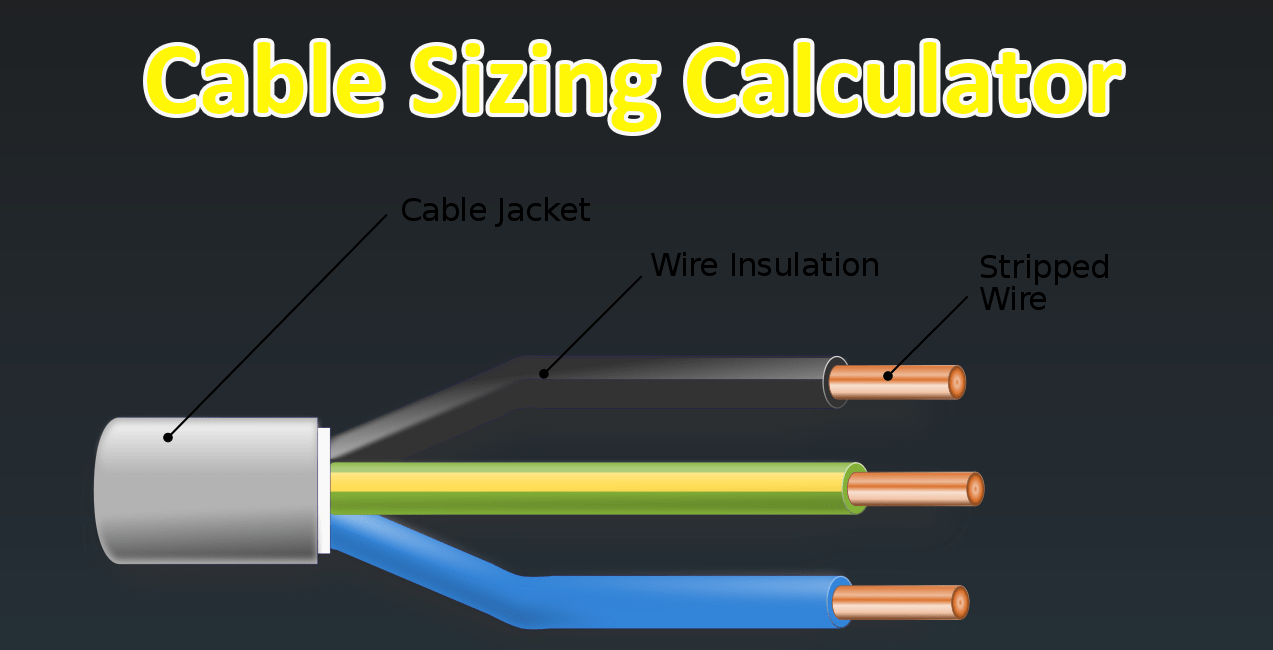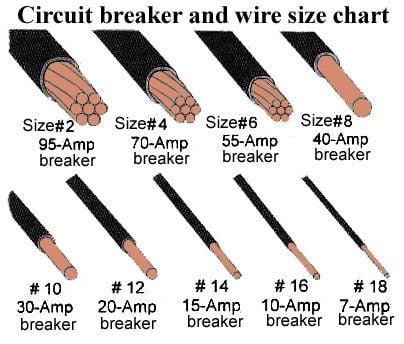
Choosing suitable circuit breaker and cable size
Choosing suitable circuit breaker and cable size
Choosing suitable circuit breaker and cable size ,
Choosing the appropriate cutter and cable capacity is one of the most important foundations of electrical wiring that you must know for its direct relationship to protecting loads and household electrical appliances.
Where circuit breakers and electrical cables are available in the market in various capacities and diameters to suit each specific electrical load.
Follow this article with us to learn how to choose the right cutter capacity and cable
Choosing suitable circuit breaker and cable size

Choosing suitable circuit breaker and cable size
The importance of installing a circuit breaker
The circuit breakers shall be installed in the sub panels with the aim of:
- Protection of electrical loads from short circuit current resulting from the contact of electrical conductors together. or breakdown of cable insulation…etc.
- Disconnecting the load from the circuit in case the load exceeds the rated current of the circuit breaker.
Choosing suitable circuit breaker and cable size
electrical cable
In order for the load or device to be fed with electric current, We need a transmission to pass the current from the electrical socket to this load to power it,
This method is called an electric cable or wire. Where the cable is manufactured with diameters of international standard specifications to carry the electric current passing through it.
Choosing suitable circuit breaker and cable size
Conditions for choosing the right electrical circuit breaker
- The circuit breaker capacitance should be 25% higher than the load current.
- Match the breaker voltage to the branch circuit voltage.
- number of electrodes.
- To comply with the International Standards (IEC).
- Chapter response speed.
- Maximum short circuit current it can withstand.
Steps to choose the appropriate cutter and cable capacity
- Determine the load current.
- Choosing the right circuit breaker capacity.
- Choose the appropriate cable diameter.
Choosing suitable circuit breaker and cable size
Determine the load current
The first step in the process of selecting the appropriate breaker capacity and cable diameter is to know the electrical load capacity in volt-amperes,
If there is more than one electrical load, The electrical loads must be sorted, For example, Suppose we have a luminous load, carry an air conditioner,
Here, the two loads must be separated so that a suitable circuit breaker is installed. And another cutter suitable for the electric conditioner.
The load current is calculated using the following relationship:
load current = load capacity (in volts-amperes or watts) x source voltage (in volts)
Electrical devices
Choosing the right circuit breaker capacity
After determining the electrical loads, Knowing the total capacity of the loads that consume electrical energy, The cutter is fitted to a specific load,
Or a group of circuit breakers distributed over several electrical load circuits.
It is always known that the circuit breaker current is 25% higher than the ohmic load current,
If the load is inductive with medium and high capacities (such as electric motors), In this case the circuit breaker current must be higher than the starting current of the electric motor.
The circuit breaker current is calculated using the following relationship:
circuit breaker = load current x 1.25
Then the nearest current capacity (amperes) to the circuit is chosen
circuit breakers
Electric cable selection
is the last step, The cable bearing capacity is estimated based on several electrical factors:
- electric load current.
- Rated current of circuit breaker: The circuit breaker protects the cable from high currents and short circuits.
- Palace current for the cable.
- The rated voltage of the cable.
- influence of weather factors.
Table for determining the maximum current of the electric cable:
| Wire diameter in (mm) | Permissible withstand current in amperes (A) |
| 2.5 | 16A |
| 4 | 22A |
| 6 | 28A |
| 10 | 39A |
| 16 | 50A |
| 25 | 66A |
Important note:
The following table shows the load current in approximate values.
But if you want to know the maximum current of a cable or electrical conductor, You should review the cable data from the catalog or the data sheet of the producing company
The appropriate cable diameter is calculated using the following relationship:
Suitable cable diameter = breaker current x 1.2
Choosing suitable circuit breaker and cable size
 Example of choosing the appropriate cutter and cable capacity
Example of choosing the appropriate cutter and cable capacity
If the single-sided power supply is 230V, 2500VA electric heater.
Required:
- load current calculation
- Choose the right cutter capacity.
- Choose the appropriate cable diameter.
We need a 16A breaker and a 2.5mm diameter cable
Choosing suitable circuit breaker and cable size
Electrical cables and their types
electrical cables and their types,
The methods of extending electrical cables and their types are among the most important foundations that you must know for their direct relationship to the field of electricity in the extension of homes, transmission lines and power.
Where the method and types of electrical cables are intertwined in home, commercial and industrial installations and external transmission networks,
Electrical cables are available in different types and diameters. And when choosing the electrical cable, it must be taken into account that it is suitable with the type of extension (external / internal),
electrical load capacity (domestic/commercial/industrial);
Based on this, the most suitable cable for connection is selected.
Follow this article with us to learn how to extend electrical cables and their types.
Read also: Types of circuit breakers
Definition of Electrical Cables (Electrical Conductors)
It is a tool for transmitting electric energy that is produced from renewable and non-renewable electric power plants to consumption areas. such as residential communities, factories, public and private institutions, and hospitals.
Where the conductor of electrical cables are made of copper or aluminum, It is covered with an insulating material to isolate the conductor from its surroundings.
electrical cables
Factors affecting the selection of electrical cables
There are several ways to extend electrical cables and their types in proportion to the place, which are as follows:
- Extension inside the wall.
- Extension inside the external pipes.
- Underground extension.
- Extension on private channels.
- Insulation of cables and connectors.
- Extension of factories with Cable Trays.
- The maximum operating voltage of the cable.
- The maximum value of the short-circuit current and its duration, Meaning that the electric cable bears the short-circuit current.
- cable length.
- Maximum temperature tolerance: Voltage drop.
electrical cable laying
Which method is chosen for laying conductors and cables depends on several different factors,
The most important of which is the nature of the project,
For example, in an industrial project, it is preferable to use Cable Trays. until the electrical conductors and cables are laid on these exposed mounts,
Thus, the surrounding air leaks heat from electrical conductors and cables.
There are several types of electrical cable laying methods:
- Inner extension (inside the wall): Such as home and commercial extensions.
- External extension via channels: The extension is carried out within the plastic channels installed on the wall.
- Extension on tripods called Cable Trays: Used inside factories and large buildings.
Indoor extension (inside the wall)
External Extension via Channels
Extension on tripods called Cable Trays
Electrical cable insulators and their types
Electrical cables and conductors are insulated by one of the following materials:
Polyvinyl chloride (PVC)
This type of insulator is suitable for low voltages, low temperatures, and cheaper price, And it is widely adopted in most internal extensions compared to other types of insulators.
Crosslinked Polyethylene (XLPE)
This is another type of insulator,
It is suitable for outdoor installations because of its advantages of bearing high temperatures and short currents. It is also moisture resistant. But the disadvantage of this type is to avoid extreme bends during extension.
Ethylene Propylene (EPR)
It is made of rubber, The rubber is water repellent. But it cannot resist flammable materials such as gasoline and petroleum.
Electrical cable insulators and their types
Simple Cable Components
Withstands electrical cables for maximum short current and duration
Each electrical cable is manufactured to a specification to withstand a maximum short-circuit current within a specified range, Therefore, before choosing the appropriate cable, the extent to which it can withstand short-circuit currents within seconds must be studied. So that we can put the maximum short current on which the circuit breaker is designed to protect the electric cable without burning.
Effect of electrical cables under voltage
The longer the cable, the smaller the cross-sectional area. The higher the voltage drop, the Thus, the increase in the value of the electric current increases.
Instructions for laying electrical cables
- Ensure that there are no combustible materials.
- Avoid placing single cable with high currents in a pipe, Because an inductive current occurs due to the creation of a magnetic field inside the pipe (induced current).
- Separation of high current power cables, weak current cables, such as telephone cable or internet cable and other weak current devices, with a distance of not less than 30 cm, To prevent magnetic interference.
- For external extensions, Special protections must be placed for electrical cables.
Conclusion:
When extending any electrical network, The nature of the building and the type of electrical loads must be known. And study the external and internal factors that may affect the choice of electrical cables and their types, in addition to the type of insulator.
Types of electrical circuit breakers
Choosing suitable circuit breaker and cable size
protection circuit breakers
Circuit breakers are one of the important elements that are used to protect wiring circuits from short-circuits, overloads, or as a result of contact between two wires or a ground leak.
such as home and industrial extensions, And other loads that may need special protections such as electric motors.
electric circuit breaker definition
Choosing suitable circuit breaker and cable size
It is a protection device that disconnects current from electrical circuits in the event of feeling that there are inappropriate malfunctions that may affect the loads.
as well as human, like an increase in current, or short circuits due to insulator breakdown, or as a result of a cut in the conductors by the occurrence of contact between its wires, Or as a result of a ground leak.
Choosing the right cutter
The specifications of the electrical circuit are determined by two important values before purchasing it:
- Rated current (Amp)
What is meant is the selection of the circuit breaker current in proportion to the load current that passes through the circuit without causing it to be disconnected. There are well known Standard values in amperes.
Examples of standard values of rated breaker current.
| rated circuit breaker | 6A | 10A | 16A | 20A | 25A | 32A | 40A |
- Palace Stream (KA)
It is meant to select the maximum short-circuit current that can be tolerated during a short circuit without burning (Short Circuit Capacity), It is measured in (KA),
It is well known that their values are high, of course, But its durability for a very short period is measured in seconds only.
Examples of standard values of short circuit capacity, measured in KA.
| Qasr Stream values | 3K | 6K | 10K | 80K | 100KA |
Classification of CBs All types of circuit breakers perform a protective function, But depending on the internal components of the circuit breaker, for example, thermal cutter,
The principle of the thermal circuit breaker is based on protection against overheating due to an increase in the current strength. Either the magnetic circuit breaker depends on the principle of magnetic effect;
There are other types of well-known electrical circuit breakers, such as electromagnetic circuit breakers, thermo-magnetic circuit breakers, and other modern circuit breakers.
This type has a quick disconnection of the current from the loads in the event of sensing a fault in the electrical circuit.
Electrical circuit breakers are categorized into several types:
1- MCB-type circuit breakers:
It is an acronym for “Miniature Circuit Breaker” This type is used to protect the main and subsidiary circuits of household wiring and ohmic loads such as lighting…. etc,
and small inductive loads such as electric motors.
MCB . Overcurrent and Overcurrent Protection Circuit Breaker
| cutter class | Operating range | the use |
| B | It ranges from 3 to 5 times the rated current. | used in ohmic loads, Such as lighting loads, heating loads and other electrical loads. |
| C | It ranges from 5 to 10 times the rated current. | It is used with inductive loads, such as air conditioners, water motors…etc. |
| D | It ranges from 10 to 20 times the rated current. | For use with high inductive loads, Like big transformers. |
A table to show the categories of MCB . circuit breakers
2- MCCB type circuit breakers:
It is an acronym for “Molded Case Circuit Breaker”. This type is used to protect the main circuits.
It is characterized by being able to withstand a higher rated electric current than the MCB breaker. It also withstands high palace currents.
MCCB Protection Circuit
Features of MCCB circuit breakers:
- It has the ability to withstand high palace currents.
- Protection of mains supply circuits with high currents.
- It withstands a higher rated current than the MCB breaker.
- The possibility of controlling the adjustment of the relationship between the disconnection time and the value of the fault current compared to the MCB breaker, which cannot be controlled.
3- GFCB type circuit breakers:
It is an acronym for “Ground Fault Circuit Breaker” This type is used to protect humans and electrical installations from earth leakage,
It builds its working principle on comparing the value of the current entering the circuit in one-phase circuits.
As for the three phase, it compares the sum of the three currents with the value of the current out of them, which is the current in the Neutral.
Therefore, when a difference occurs between the incoming and outgoing current, this means that there is a current leakage outside the circuit, as a result of which the electric circuit is separated from the sources of supply.
GFCB Protection Circuit Breaker=======>
Choosing suitable circuit breaker and cable size
Ground Leakage Breaker Business Idea
Ground Leakage Breaker Business Idea
earth leakage circuit breaker business idea, A circuit breaker must be present in every electricity network, whether it is a home network, residential building, commercial or industrial.
The task of this circuit breaker is to detect any current leakage that may occur as a result of poor wire insulation, any fault caused by electrical connections, or an electric shock.
Therefore, it has become necessary and necessary to install the circuit breaker in all electrical panels in general, and especially home panels in particular.
Let’s get to know the leakage breaker, and its components, Earth leakage circuit breaker, available market capacities and sensitivity classes.
Differential circuit breakers or earth leakage circuit breakers
Choosing suitable circuit breaker and cable size
earth leakage circuit breaker
Also known as Ground Fault CB, Drop Fault CB. The cutter has other names and symbols. Like:
- (RCD) is an acronym for “Residual Current Detector”.
- (ELCB) is an acronym for “Earth Leakage Circuit Breaker”.
- (GFI) is an acronym for “Ground Fault Interrupter”.
This type is used for protection against current Leaking to the ground in electrical wiring, It is separated based on the degree of sensitivity current to which it is designed.
Among the most popular sensitivity values available in the market are: (5mA-30mA-300mA), The lower the sensitivity, the higher the price.
Class 1 (5mA) devices are expensive, It is used only with devices that are affected by the slightest sensitivity.
There are many rated current values of the breaker that it can withstand at all times, Among the most famous of these values are: 32 amps, 40 amps, 63 amps, 100 amps.
Choosing suitable circuit breaker and cable size
Choosing suitable circuit breaker and cable size
Earth Leakage Circuit Breaker Components
- The circuit consists of the input points and the output points. It comes with either two poles or four poles only. It has entry points and exit points.
- The circuit breaker is usually equipped with a T test key, which is a series-connected push button with a large resistance in order to test the serviceability of the breaker.
Choosing suitable circuit breaker and cable size
Ground Leakage Breaker Business Idea
The idea of his work is similar to Kirchhoff’s law of current ,
The idea of his work is based on comparing the value of the current entering the circuit (the current of one phase or three phases) with the value of the current leaving it (the current in the neutral).
If a difference occurs between the incoming and outgoing current, this is evidence of a current leakage outside the original circuit
, this small difference will cause an overflow in the inner metal ring,
leading to the rupture of the internal coil, Thus, it will generate a magnetic force that opens the circuit, This difference in current will be the largest specific value called “device sensitivity”.
The circuit breaker in the normal case is the sum of the currents of the three phases or one phase (directional sum) equal to the return current in the neutral
, the flux created inside the magnetic ring is zero.
Choosing suitable circuit breaker and cable size
Connect the breaker inside a distribution board
The breaker is connected in series after the main breaker inside the sub-distribution board, whether in the case of a 3-phase or 1-phase panel.
Diagram showing the connection of a differential breaker inside a distribution board
Very important note:
It must be ensured that all Neutral lines are connected through the main Neutral of the leakage circuit breaker,
Any Neutral line that is not connected to the neutral bridge designated for the leakage circuit breaker will cause the breaker to disconnect immediately.
In the event of repeated disconnection, This indicates that there is a current leakage in the electrical connections connected by the ground leakage circuit breaker
Then all connections must be checked, and loads must be run gradually one by one to determine the location of the fault.
Choosing suitable circuit breaker and cable size
 Choosing suitable circuit breaker and cable size
Choosing suitable circuit breaker and cable size
read more at our blog
We are pleased to have you visit our pages on social networking sites, where we publish exclusive offers on our website.
Our Facebook page here .
Our Twitter account is here .






